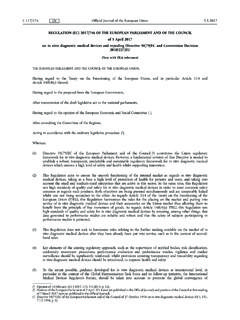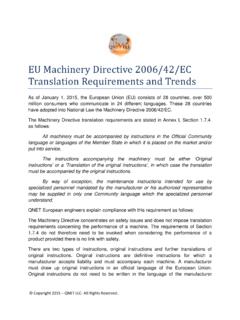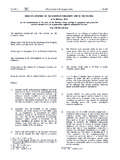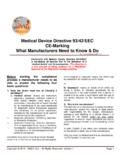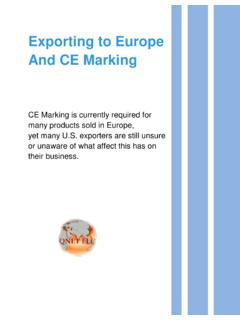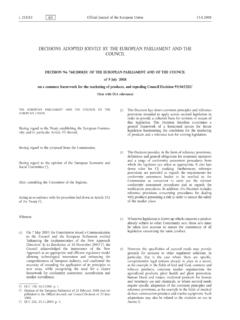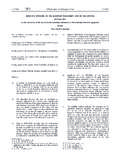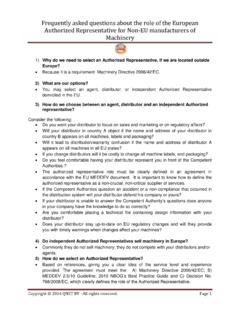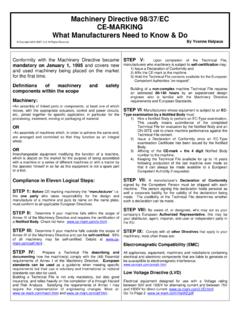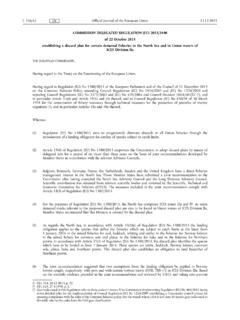Transcription of REGULATION (EU) 2017/ 745 OF THE EUROPEAN …
1 I (Legislative acts) REGULATIONS REGULATION (EU) 2017/ 745 OF THE EUROPEAN PARLIAMENT AND OF THE COUNCIL of 5 April 2017 on medical devices, amending Directive 2001/83/EC, REGULATION (EC) No 178/2002 and REGULATION (EC) No 1223/2009 and repealing Council Directives 90/385/EEC and 93/42/EEC (Text with EEA relevance) THE EUROPEAN PARLIAMENT AND THE COUNCIL OF THE EUROPEAN UNION, Having regard to the Treaty on the Functioning of the EUROPEAN Union, and in particular Article 114 and Article 168(4)(c) thereof, Having regard to the proposal from the EUROPEAN Commission, After transmission of the draft legislative act to the national parliaments, Having regard to the opinion of the EUROPEAN Economic and Social Committee (1), After consulting the Committee of the Regions, Acting in accordance with the ordinary legislative procedure (2), Whereas: (1) Council Directive 90/385/EEC (3) and Council Directive 93/42/EEC (4) constitute the Union regulatory framework for medical devices, other than in vitro diagnostic medical devices.
2 However, a fundamental revision of those Directives is needed to establish a robust, transparent, predictable and sustainable regulatory framework for medical devices which ensures a high level of safety and health whilst supporting innovation. (2) This REGULATION aims to ensure the smooth functioning of the internal market as regards medical devices, taking as a base a high level of protection of health for patients and users, and taking into account the small- and medium-sized enterprises that are active in this sector. At the same time, this REGULATION sets high standards of quality and safety for medical devices in order to meet common safety concerns as regards such products.
3 Both objectives are being pursued simultaneously and are inseparably linked whilst one not being secondary to the other. As regards Article 114 of the Treaty on the Functioning of the EUROPEAN Union (TFEU), this REGULATION harmonises the rules for the placing on the market and putting into service of medical devices and their accessories on the Union market thus allowing them to benefit from the principle of free movement of goods. L 117/1 Official Journal of the EUROPEAN Union EN (1) Opinion of 14 February 2013 (OJ C 133, , p. 52). (2) Position of the EUROPEAN Parliament of 2 April 2014 (not yet published in the Official Journal) and position of the Council at first reading of 7 March 2017 (not yet published in the Official Journal).
4 (3) Council Directive 90/385/EEC of 20 June 1990 on the approximation of the laws of the Member States relating to active implantable medical devices (OJ L 189, , p. 17). (4) Council Directive 93/42/EEC of 14 June 1993 concerning medical devices (OJ L 169, , p. 1). As regards Article 168(4)(c) TFEU, this REGULATION sets high standards of quality and safety for medical devices by ensuring, among other things, that data generated in clinical investigations are reliable and robust and that the safety of the subjects participating in a clinical investigation is protected. (3) This REGULATION does not seek to harmonise rules relating to the further making available on the market of medical devices after they have already been put into service such as in the context of second-hand sales.
5 (4) Key elements of the existing regulatory approach, such as the supervision of notified bodies, conformity assessment procedures, clinical investigations and clinical evaluation, vigilance and market surveillance should be significantly reinforced, whilst provisions ensuring transparency and traceability regarding medical devices should be introduced, to improve health and safety. (5) To the extent possible, guidance developed for medical devices at international level, in particular in the context of the Global Harmonization Task Force (GHTF) and its follow-up initiative, the International Medical Devices Regulators Forum (IMDRF)
6 , should be taken into account to promote the global convergence of regulations which contributes to a high level of safety protection worldwide, and to facilitate trade, in particular in the provisions on Unique Device Identification, general safety and performance requirements, technical documen tation, classification rules, conformity assessment procedures and clinical investigations. (6) For historical reasons, active implantable medical devices, covered by Directive 90/385/EEC, and other medical devices, covered by Directive 93/42/EEC, were regulated in two separate legal instruments.
7 In the interest of simplification, both directives, which have been amended several times, should be replaced by a single legislative act applicable to all medical devices other than in vitro diagnostic medical devices. (7) The scope of application of this REGULATION should be clearly delimited from other Union harmonisation legislation concerning products, such as in vitro diagnostic medical devices, medicinal products, cosmetics and food. Therefore, REGULATION (EC) No 178/2002 of the EUROPEAN Parliament and of the Council (1) should be amended to exclude medical devices from its scope.
8 (8) It should be the responsibility of the Member States to decide on a case-by-case basis whether or not a product falls within the scope of this REGULATION . In order to ensure consistent qualification decisions in that regard across all Member States, particularly with regard to borderline cases, the Commission should be allowed to, on its own initiative or at the duly substantiated request of a Member State, having consulted the Medical Device Coordination Group ( MDCG ), decide on a case-by-case basis whether or not a specific product, category or group of products falls within the scope of this REGULATION .
9 When deliberating on the regulatory status of products in borderline cases involving medicinal products, human tissues and cells, biocidal products or food products, the Commission should ensure an appropriate level of consultation of the EUROPEAN Medicines Agency (EMA), the EUROPEAN Chemicals Agency and the EUROPEAN Food Safety Authority, as relevant. (9) Since in some cases it is difficult to distinguish between medical devices and cosmetic products, the possibility of taking a Union-wide decision regarding the regulatory status of a product should also be introduced in REGULATION (EC) No 1223/2009 of the EUROPEAN Parliament and of the Council (2).
10 (10) Products which combine a medicinal product or substance and a medical device are regulated either under this REGULATION or under Directive 2001/83/EC of the EUROPEAN Parliament and of the Council. (3) The two legislative acts should ensure appropriate interaction in terms of consultations during pre-market assessment, and of exchange of information in the context of vigilance activities involving such combination products. For medicinal products that integrate a medical device part, compliance with the general safety and performance requirements laid down in this REGULATION for the device part should be adequately assessed in the context of the marketing authorisation for such medicinal products.
